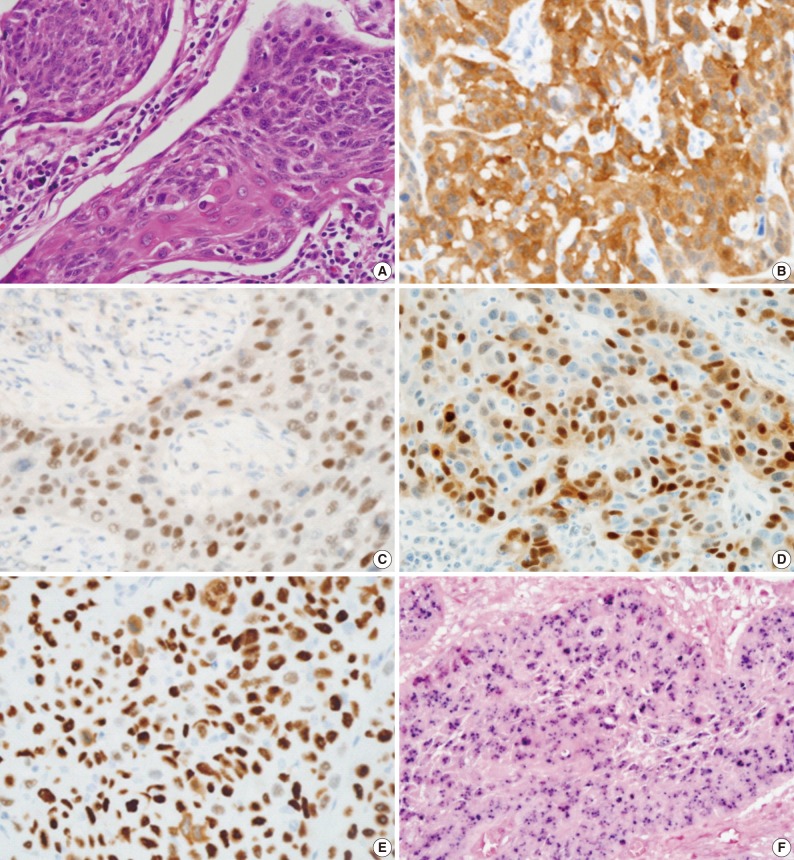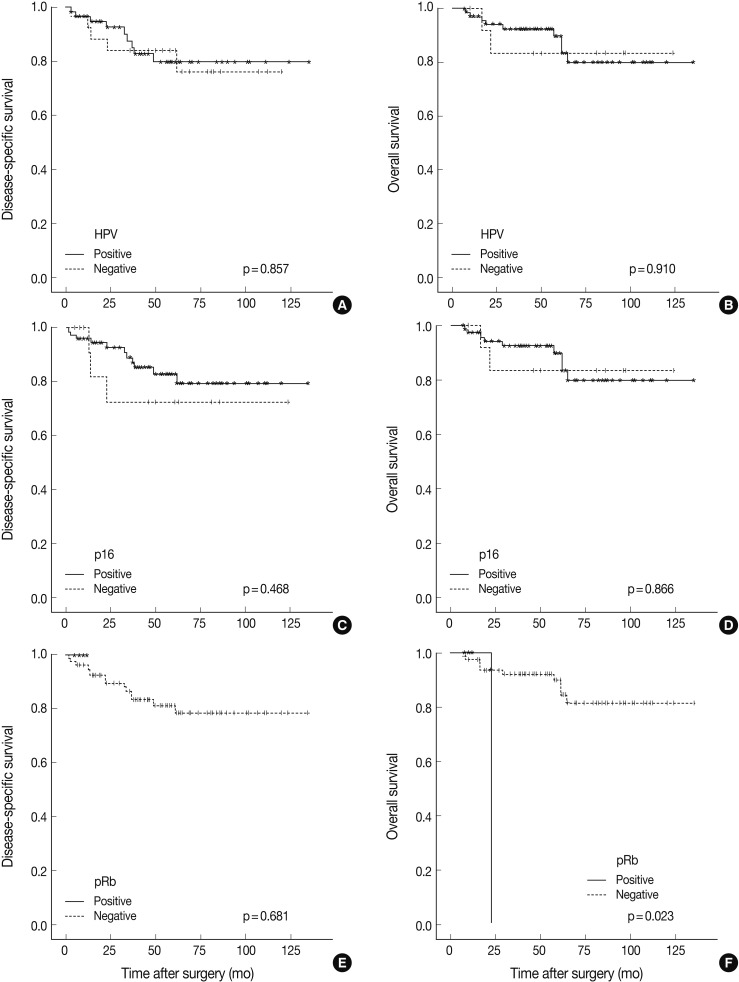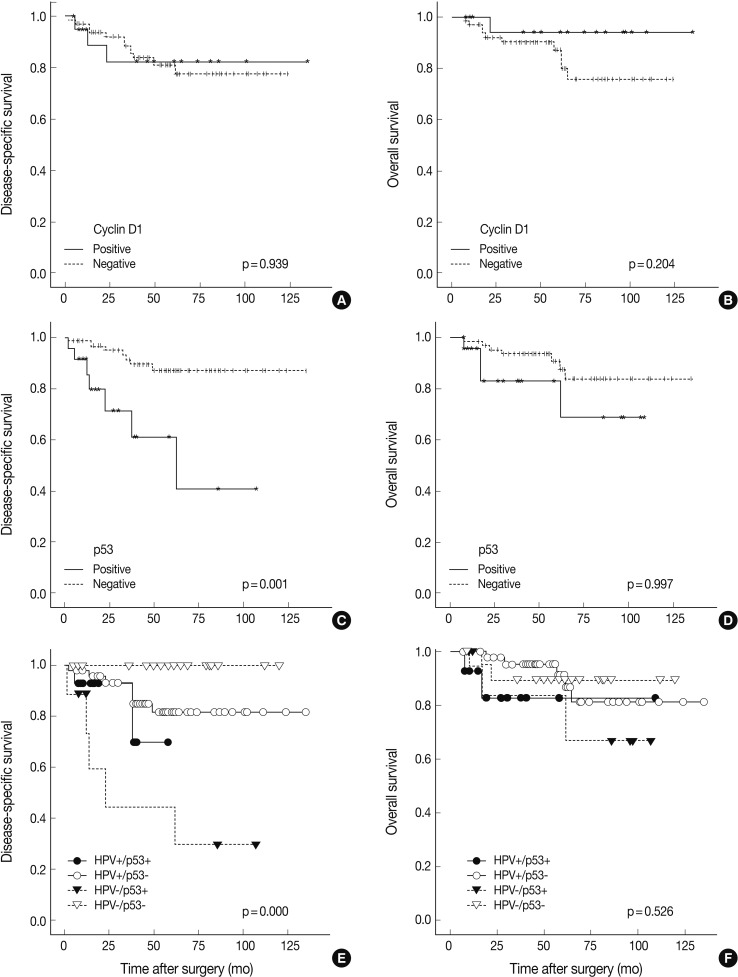Articles
- Page Path
- HOME > J Pathol Transl Med > Volume 47(2); 2013 > Article
-
Original Article
Human Papillomavirus Prevalence and Cell Cycle Related Protein Expression in Tonsillar Squamous Cell Carcinomas of Korean Patients with Clinicopathologic Analysis - Miji Lee, Sung Bae Kim1, Sang-wook Lee2, Jong-Lyel Roh3, Seung-Ho Choi3, Soon Yuhl Nam3, Sang Yoon Kim3, Kyung-Ja Cho
-
Korean Journal of Pathology 2013;47(2):148-157.
DOI: https://doi.org/10.4132/KoreanJPathol.2013.47.2.148
Published online: April 24, 2013
Department of Pathology, Asan Medical Center, University of Ulsan College of Medicine, Seoul, Korea.
1Department of Medical Oncology, Asan Medical Center, University of Ulsan College of Medicine, Seoul, Korea.
2Department of Radiation Oncology, Asan Medical Center, University of Ulsan College of Medicine, Seoul, Korea.
3Department of Head and Neck Surgery, Asan Medical Center, University of Ulsan College of Medicine, Seoul, Korea.
- Corresponding Author: Kyung-Ja Cho, M.D. Department of Pathology, University of Ulsan College of Medicine, Asan Medical Center, 88 Olympic-ro 43-gil, Songpa-gu, Seoul 138-736, Korea. Tel: +82-2-3010-4545, Fax: +82-2-472-7898, kjc@amc.seoul.kr
© 2013 The Korean Society of Pathologists/The Korean Society for Cytopathology
This is an Open Access article distributed under the terms of the Creative Commons Attribution Non-Commercial License (http://creativecommons.org/licenses/by-nc/3.0/) which permits unrestricted non-commercial use, distribution, and reproduction in any medium, provided the original work is properly cited.
Figure & Data
References
Citations

- Assessment of the Mutation Profile of Tonsillar Squamous Cell Carcinomas Using Targeted Next-Generation Sequencing
Ha Young Park, Joong Seob Lee, Jee Hye Wee, Jeong Wook Kang, Eun Soo Kim, Taeryool Koo, Hee Sung Hwang, Hyo Jung Kim, Ho Suk Kang, Hyun Lim, Nan Young Kim, Eun Sook Nam, Seong Jin Cho, Mi Jung Kwon
Biomedicines.2023; 11(3): 851. CrossRef - Clinicopathologic characterization of cervical metastasis from an unknown primary tumor: a multicenter study in Korea
Miseon Lee, Uiree Jo, Joon Seon Song, Youn Soo Lee, Chang Gok Woo, Dong-Hoon Kim, Jung Yeon Kim, Sun Och Yoon, Kyung-Ja Cho
Journal of Pathology and Translational Medicine.2023; 57(3): 166. CrossRef - Negative Prognostic Implication of TERT Promoter Mutations in Human Papillomavirus–Negative Tonsillar Squamous Cell Carcinoma Under the New 8th AJCC Staging System
Hyunchul Kim, Mi Jung Kwon, Bumjung Park, Hyo Geun Choi, Eun Sook Nam, Seong Jin Cho, Kyueng-Whan Min, Eun Soo Kim, Hee Sung Hwang, Mineui Hong, Taeryool Koo, Hyo Jung Kim
Indian Journal of Surgical Oncology.2021; 12(S1): 134. CrossRef - Prevalence of high-risk human papillomavirus and its genotype distribution in head and neck squamous cell carcinomas
Yuil Kim, Young-Hoon Joo, Min-Sik Kim, Youn Soo Lee
Journal of Pathology and Translational Medicine.2020; 54(5): 411. CrossRef - Frequent hepatocyte growth factor overexpression and low frequency of c-Met gene amplification in human papillomavirus–negative tonsillar squamous cell carcinoma and their prognostic significances
Mi Jung Kwon, Dong Hoon Kim, Hye-Rim Park, Hyung Sik Shin, Ji Hyun Kwon, Dong Jin Lee, Jin Hwan Kim, Seong Jin Cho, Eun Sook Nam
Human Pathology.2014; 45(7): 1327. CrossRef
 PubReader
PubReader ePub Link
ePub Link-
 Cite this Article
Cite this Article
- Cite this Article
-
- Close
- Download Citation
- Close
- Figure



Fig. 1
Fig. 2
Fig. 3
| Variables | Total | HPV-positive | HPV-negative | p-value |
|---|---|---|---|---|
| Gender | 1.000 | |||
| Male | 81 (91) | 54 (60.7) | 27 (30.3) | |
| Female | 8 (9) | 5 (5.6) | 3 (3.4) | |
| Age (yr) | 0.005 |
|||
| ≤ 60 | 64 (72) | 48 (54) | 16 (18) | |
| > 60 | 25 (28) | 11 (12.3) | 14 (15.7) | |
| Tobacco use | 0.490 | |||
| Non-smoker | 28 (31.5) | 21 (23.6) | 7 (7.9) | |
| Former smoker | 8 (9) | 5 (5.6) | 3 (3.4) | |
| Current smoker | 53 (59.5) | 33 (37.1) | 20 (22.4) | |
| Alcohol consumption | 0.907 | |||
| No history | 27 (30.3) | 18 (20.2) | 9 (10.1) | |
| ≤ 3 drinks per day | 26 (29.2) | 18 (20.2) | 8 (9) | |
| > 3 drinks per day | 36 (40.5) | 23 (25.9) | 13 (14.6) | |
| Tumor size (cm) | 0.039 |
|||
| ≤ 4 | 78 (87.6) | 55 (61.8) | 23 (25.8) | |
| > 4 | 11 (12.4) | 4 (4.5) | 7 (7.9) | |
| T stage | 0.156 | |||
| T1 and T2 | 70 (78.7) | 49 (55.1) | 21 (23.6) | |
| T3 and T4 | 19 (21.3) | 10 (11.2) | 9 (10.1) | |
| N stage | 0.247 | |||
| N0 | 10 (11.2) | 5 (5.6) | 5 (5.6) | |
| N1, N2, and N3 | 79 (88.8) | 54 (60.7) | 25 (28.1) | |
| M stage | 0.659 | |||
| M0 | 83 (93.2) | 54 (60.7) | 29 (32.6) | |
| M1 | 6 (6.8) | 5 (5.6) | 1 (1.1) | |
| Anatomic stage | 0.970 | |||
| I and II | 18 (20.2) | 12 (13.5) | 6 (6.7) | |
| III and IV | 71 (79.8) | 47 (52.8) | 24 (27.0) |
| Variables | Total | HPV-positive | HPV-negative | p-value |
|---|---|---|---|---|
| p16 | < 0.001 |
|||
| Positive | 74 (83.1) | 57 (64.0) | 17 (19.1) | |
| Negative | 15 (16.9) | 2 (2.3) | 13 (14.6) | |
| pRb | 0.003 |
|||
| Positive | 5 (5.6) | 0 (0) | 5 (5.6) | |
| Negative | 84 (94.4) | 59 (66.3) | 25 (28.1) | |
| Cyclin D1 | < 0.001 |
|||
| Positive | 21 (23.6) | 6 (6.7) | 15 (16.9) | |
| Negative | 68 (76.4) | 53 (59.5) | 15 (16.9) | |
| p53 | 0.334 | |||
| Positive | 24 (27.0) | 14 (15.7) | 10 (11.3) | |
| Negative | 65 (73.0) | 45 (50.5) | 20 (22.5) |
| Variables | Total | HPV-positive | HPV-negative | p-value |
|---|---|---|---|---|
| Tumor origin | 0.075 | |||
| Crypt | 64 (71.9) | 46 (51.7) | 18 (20.2) | |
| Surface | 25 (28.1) | 13 (14.6) | 12 (13.5) | |
| Differentiation | 0.128 | |||
| WD | 16 (18.0) | 8 (9.0) | 8 (9.0) | |
| MD and PD | 73 (82.0) | 51 (57.3) | 22 (24.7) | |
| Keratinization | 0.832 | |||
| Keratinizing | 31 (34.8) | 21 (23.6) | 10 (11.2) | |
| Non-keratinizing | 58 (65.2) | 38 (42.7) | 20 (22.5) | |
| LN metastasis | 0.367 | |||
| Cystic | 37 (41.5) | 27 (30.3) | 10 (11.2) | |
| Non-cystic | 52 (58.5) | 32 (36.0) | 20 (22.5) |
Values are presented as number (%). HPV, human papillomavirus; TSCCs, tonsillar squamous cell carcinomas. Statistically significant.
Values are presented as number (%). HPV, human papillomavirus; TSCCs, tonsillar squamous cell carcinomas. Statistically significant.
Values are presented as number (%). HPV, human papillomavirus; WD, well differentiated; MD, moderately differentiated; PD, poorly differentiated; LN, lymph node.

 E-submission
E-submission








